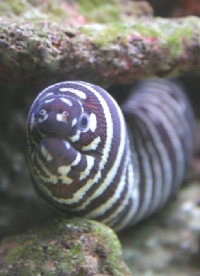Eels are fantastic additions to a tank, if you can provide it with needs such as a large tank, appropriate hiding spaces and alot of attention
Other Scientific Names: Echidna Zebra – formerly known as
Common Names: Zebra Moray Eel, Zebra Eel, Eel, Moray
Class: Actinopterygii (ray-finned fishes)
Order: Anguilliformes (eels, morays)
Family: Muraenidae
Origin: Indo-Pacific: Red Sea and East Africa, Hawaiian islands, Australia – Great Barrier Reef. Eastern Central Pacific, Mexico
Main Ecosystem: Marine
Salinity: 1.020 – 1.025
Temperment: Docile
Diet: Carnivore
Care: Molluscs, shrimp, crab meats. Do not feed silversides as they tend to contain alot of fatty acids. It is possible to do so, but not on a regular basis. May need to use a feeding stick until you become familiar with your eels personality. When food is present it may take on a more aggressive behavior. Eels do not eat on a daily basis. Feedings 1 or 2 times a week should be sufficient, and then only feed them as much as they will consume. From time to time this eel goes into what we describe as a “hibernation” period, often hiding and not eating for several weeks or so. A tight fitting lid is needed as some eels try to escape the tank due to their curious natures. May eat inverts but if kept well fed will be fine. Rockwork or a cave is recommended for eel to hide and feel safe. May use pvc piping to create this. A heavy waste producer, a skimmer is needed, or heavy water changes frequently. Is reef safe apart from the caution with inverts.
Tank Size: minimum 75gal, recommended 100gal. Length – 4 feet plus
ph: 8.1-8.4
Temperature: 72-78 degrees Fahrenheit
Potential size: 3-4 feet in captivity. May reach a bigger size in the wild.
Water Region: Bottom dweller. Caves, reefs.
Activity: Nocturnal, more active during the evening.
Lifespan: Unknown at this stage, reported specimens of 20+ years.
Color: Chocolate brown with white stripes / Black with white stripes (like a zebra)
Mouth: Differs from other morays by having blunt, pebble-like grinding teeth (molars) with which they use to crush shelled invertebrate prey they feed on, primarily crabs, shrimps and mollusks.
Sexing: Unknown at this stage.
Acclimation:
Drip method:
1) Float the bag in the tank for approximately 20-30 minutes (adjusts temperature)
2) Gently empty the bag into a 5 gallon bucket (make sure there is enough water for the fish)
3) Cover bucket with egg crate (prevents jumping/carpet surfing)
4) Run a piece of airline tubing from the quarantine tank to the bucket
5) Start siphon
6) Tie a knot in the tubing to control flow rate, adjust to 1-3 drops per second
7) Allow to drip until the bucket has 3-4 times as much water as when you started (should take a couple of hours)
Gently net fish and place in the quarantine tank
Breeding: Unknown.
Comments: My most loved and research marine inhabitant, eels are fantastic additions to a tank, if you can provide it with needs such as a large tank, appropriate hiding spaces and alot of attention. My zebra is a great guy, and has formed a symbiotic relationship with my 2 cleaner shrimp. I hand feed mine, as well as my snowflake moray eel and have never been bitten. I just cant say how much I love eels and their personalities.. GREAT creatures!!
Sources:
http://animal-world.com/encyclo/marine/eels/zebramoray.php
http://www.wetwebmedia.com/zebramor.htm
http://species.fishindex.com/species_1495gymnomuraena_zebra_zebra_moray_eel_hawaii.html



